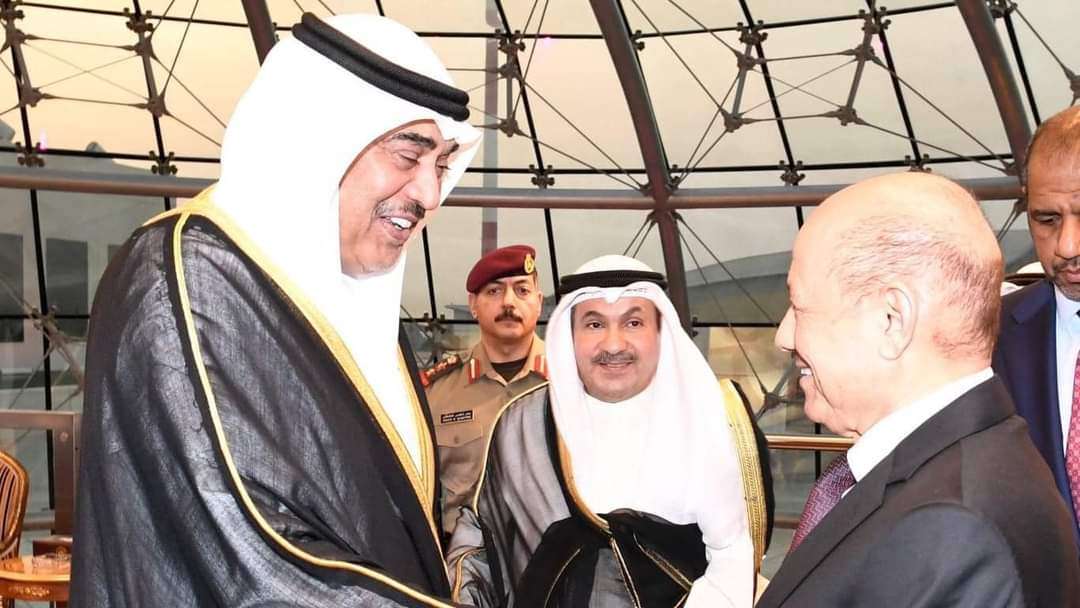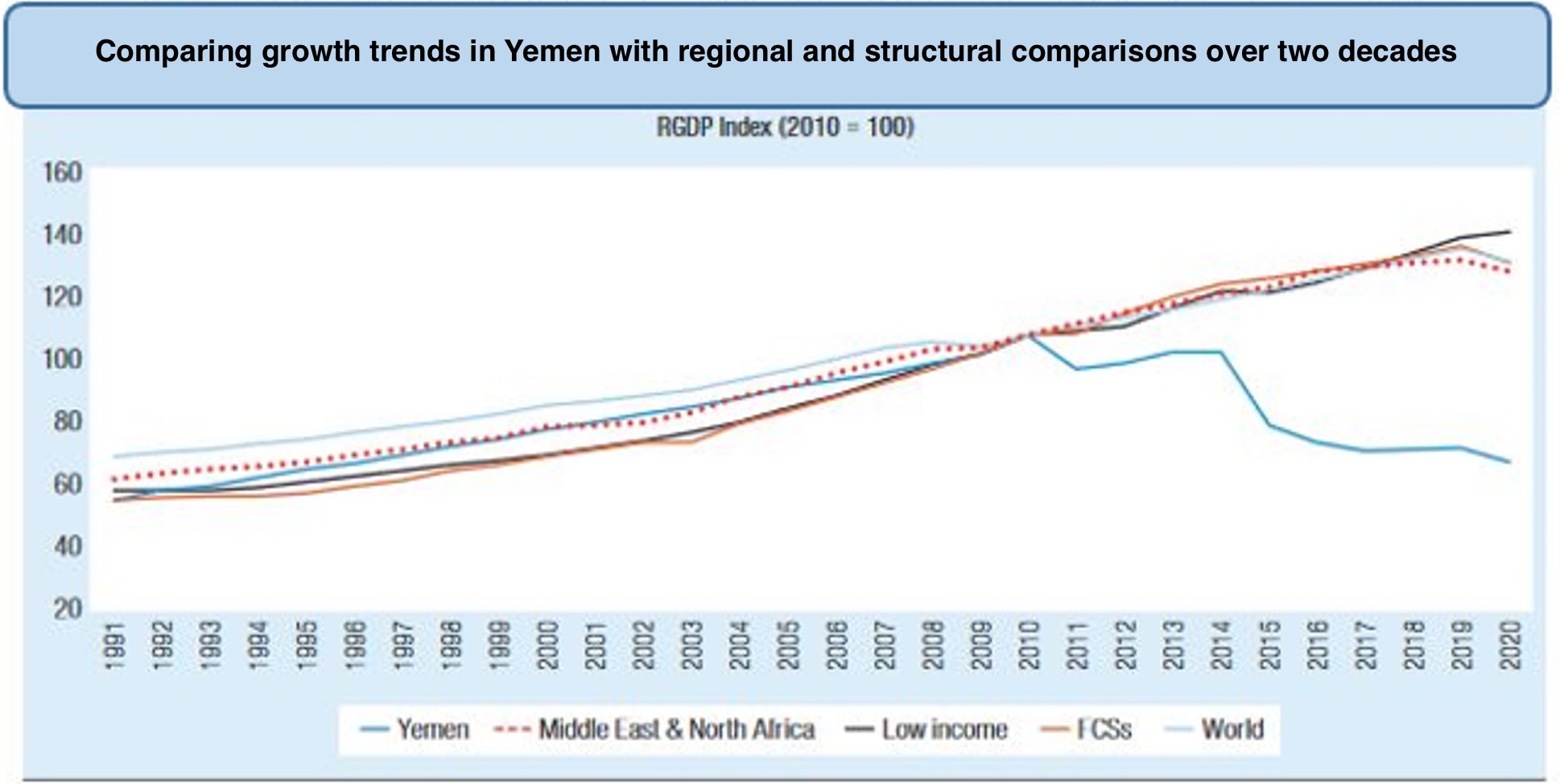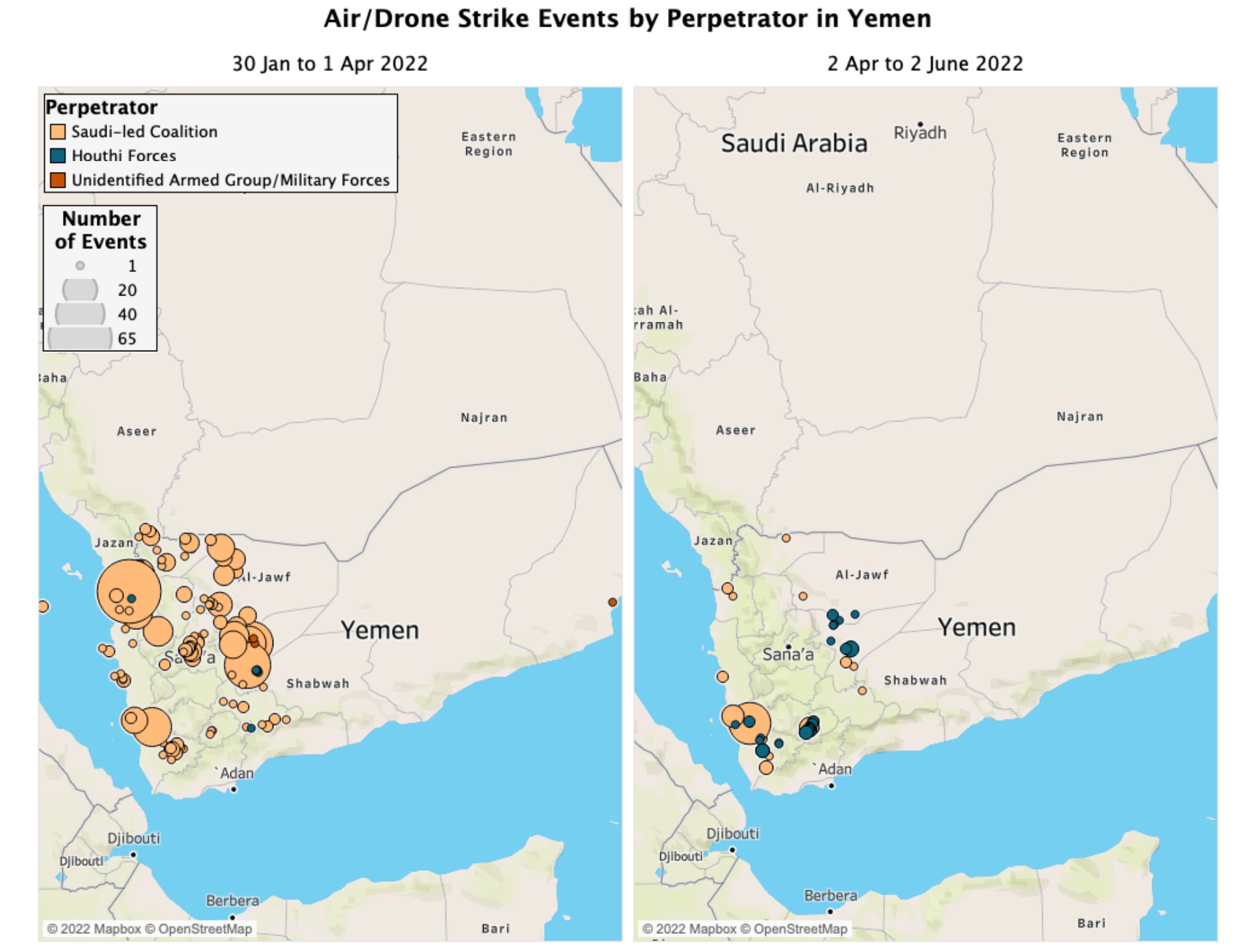
Rashad Al-Alimi being received by the Kuwaiti Prime Minister at Kuwait Airport, June 6, 2022 (official)
26-06-2022 at 5 PM Aden Time

Nancy Zidan (South24)
Yemen faces a deep economic crisis that threatens the government's ability to maintain vital public services. The Yemeni economic productivity has been remarkably reduced to about half of its pre-conflict level. The climate events and the economic repercussions caused by the COVID-19 pandemic and the Ukrainian war have much impact in addition to the big damage that hit the vital infrastructure. Amid these conditions, a delegation of Presidential Leadership Council (PLC) carried an Arab tour that included Kuwait, Egypt, and Qatar seeking for partners and donors who can aid Yemen in its complicated ordeal in addition to its Saudi and Emirati partners.
A glimpse into Yemen's economically and socially
Yemen suffers from a high inflation rates pushed by the rise in global commodity prices and the decrease of the currency value along with the Ukrainian war implications. The latter played the biggest role in the additional increase of the critical imports prices including wheat, the second-biggest imported commodity in Yemen after fuel (half of the Yemeni wheat imports come from Russia and Ukraine). At the local level, the decline of the currency value contributed to a 20-30% increase in the prices of local food products. Moreover, these dynamics have aggravated the severe food crisis. The World Food Program (WFP) expects a 6-month financing shortage of 0.7 billion dollars in Yemen to meet the necessary needs for about 13 million persons [1]. The official estimates of the food security status in Yemen have significantly worsened during the past two years. The rate of those who suffer from severe food insecurity increased from 45% of the population in 2020 to about 58% in 2022. The main reasons behind the skyrocketing prices include the rise in global food commodities, the big decline of vital food aids in the areas controlled by the Houthis, and the decreasing value of the currency in areas controlled by the internationally recognized government which led to the rise of food products [2].
Although Yemen is an oil country as the oil sector dominated the economy for about two decades, it has a limited impact on the people's welfare. Between 2005-2014, oil production was the most important element of the gross domestic product (GDP). The oil sector contributed in 75% of the total public revenues. However, the growth pushed by oil led to the expansion of the non-tradable services sector at the expense of the agricultural and industrial sectors. Thus, the Yemeni internal conditions have been quickly affected by the growing conflicts. The national poverty rate increased from 34% in 2005 to 48% in 2014. The escalation of tension between 2005-2014 led to a sharp decline in oil production [3]. This had the biggest negative impact on the GDP and reduced the government's revenues. Although the unavailability of official statistics, the World Bank indicated that the real GDP shrank by 50% over the past decade apart from 2018 when the donors' aid increased and the oil production temporarily rose after the semi-complete lockdown which began in 2015.
A series of new local and external shocks including the COVID-19 pandemic and Cholera epidemic along with the climate-related natural disasters cause several waves of recession in 2020/2021 to the extent that purchasing power, especially in South Yemen deteriorated and the consumption rate was undermined. All of this has mingled with the war ramifications including weakened trade, persistent capital losses, closed ports, shortages in foreign currencies, and the exchange rate fluctuations. Thus, the performance of the estimated total Yemeni economy since 2010 is poor despite its oil revenues when we compare it at the regional and the structural levels including other fragile states [4].

This reveals to what extent Yemen is not a poor country regarding oil resources, strategic location, and vital ports but it suffers a long-term conflict and its resources were plundered as Yemen became an arena of Iranian influence and proxy wars. However, according to the following graph, the Yemeni population increased by 30 million people. Youth and children constitute the highest percentage of the population. This is one of the factors which requires unifying efforts to save Yemen and its people from the clutches of terrorism and corruption. This could be done by supporting the peace process to reach a conciliatory formula which guarantees a stable life.
The first PLC external tour
After 50 days since ascending to power, Rashad Al-Alimi-led PLC delegation made its first external tour which included the Arab states, Kuwait, Egypt, and Qatar respectively as well as passing by the KSA on the way back to Aden [5]. There is no doubt that Yemen needs help from its Arab incubator. Its regional partner's support has to be activated to tighten the Iranian expansion in Yemen which exacerbated to the extent that caused deep harm to Yemen's neighbors.
Riyadh engaged in five rounds of negotiations and diplomatic talks with Tehran in Iraq. The most important outcome of these rounds despite their limited nature is that Iran has not yet sent another diplomatic representative to the Houthis after the death of Hassan Erlo. Thus, there is no chance to recognize the Houthis as a de-facto government in Sanaa [6], especially after Riyadh sponsored the establishment of the PLC in last April. Furthermore, a temporary truce was arranged. The UN, with US-EU support announced extending it for two additional months in an attempt to confront the hard humanitarian conditions and open new diplomatic lanes to accomplish the peace operation [7]. Likewise, before the external tour, the PLC ratified the formation of the Joint Security and Military Committee to discuss unifying all forces under the Defense and Interior ministries to achieve security and stability in light of Article 5 of the Transfer of Power Declaration in the Country [8].
In its tour, the PLC delegation selected heavyweight countries which play roles in the Yemen crisis. The tour began in Kuwait which has a long history of engaging with the developments inside Yemen. Kuwaiti diplomatic involvement in Yemen dates back to 1967 [9]. Moreover, Kuwaiti officials always stress that the Yemeni crisis can only be solved through a political operation, not by military means. Therefore, Kuwait has played a minimal role in the Arab Coalition's military operations in Yemen since 2015. The Kuwaiti participation in the Coalition's airstrikes remained limited. The Kuwaiti ground forces deployed along the Saudi and the Emirati borders [10]. In February, Kuwait Fund for Arab Economic Development and United Nations Development Program signed a new agreement to supply five hospitals in Yemen with solar energy capabilities and develop the health healthcare sector to provide better medical services to about 100000 patients in critical cases. This came as part of a Kuwaiti pledge announced at a conference held in 2021 to support the humanitarian situation in Yemen by delivering a 20 million $ grant from the Kuwaiti Fund [11].
Therefore, Kuwaiti officials pledged to the "PLC delegation" during the latter's visit to reconsider enhancing support in different cooperation programs, especially at the economic, humanitarian, political, and service levels. This includes increasing the number of academic scholarships in security and military fields and delivering the necessary facilities to the Yemeni expatriates and their sons in Kuwait [12].
Egypt was the second destination of the PLC delegation’s tour. The Yemenis look at Cairo as a reliable partner. The delegation enjoyed a warm reception by President El-Sisi in Al-Ittihadiya Palace in Cairo. They "discussed challenges that face Yemen and the importance of pushing forward the political operation to end the suffering of the brotherly Yemeni people". Al-Alimi praised the good treatment of the Yemeni community in Egypt. The two sides discussed the possibility to receive Egyptian support in the reconstruction, building, and development operation in Yemen like what happened in Iraq [13]. They stressed the need to intensify efforts to protect the security and the navigation freedom in the Red Sea, Bab Al-Mandab Strait, and the Arab Gulf. This vital issue is connected with regional and international security and stability.
Recently, the US Naval Forces Central Command (NAVCENT) also stressed the importance of enhancing security in the Red Sea, where the vital Bab Al-Mandab strait is located and Yemen is its main gate. Egypt is very interested in guaranteeing the security and stability of this maritime zone. For that, Egypt established the Berenice Military Base in 2020 which is the biggest military base in the Red Sea [15].
Prior to that, Egypt announced in May new direct air flights between Cairo and Sanaa for the first time since the beginning of the conflict. In early June, US President Joe Biden praised the role played by Egypt, Jordan, Oman, and Saudi Arabia in reaching the UN-led truce in Yemen [16]. The Egyptian role in the Yemeni crisis emerges and increases when the interactions take a regional form. This is attributed to the Egyptian ability to support the dialogue mechanism at different levels due to the strong relationship between Egypt and the KSA which is the main actor. Furthermore, Egypt has close ties with Jordan which hosts regional and international discussions to crystallize solutions for the peace operations developments in Yemen. Egypt also has experience in supporting development in Iraq and sponsoring Libya's political operation. Egypt also was ready to work with Syria as part of a group of Arab States that wish to establish stability in the region [17].
The PLC delegation ended its tour by visiting Doha. Emir of Qatar stressed Doha's interest to support the existing political consensus within the PLC along with its economic and service reforms as well as alleviating the suffering of the Yemeni people. Additionally, the meeting between some members of the PLC’s delegation and the Head of Qatar's Chamber of Commerce and Industry [18] may reflect Qatari development and investment interest.
Facts and recommendations
Along with these developments, the most prominent change in the patterns of political violence thanks to the truce which was extended to August is the sharp decline in airstrikes and drone attacks during its first two months. They decreased by 78% in comparison with the previous two months (see the map below). They decreased by 61% in comparison with the same period of 2021. The first period of the truce lasted 62 days from April 2nd to June 2nd. Armed Conflict Location and Event Data Project (ACLED) holds a comparison with the period which preceded the truce (from Jan30th to April 1st) [19].

Sources: (ACLED)
Although the truce has been able to stop the war, the Yemeni government and the Houthi militias exchanged accusations of committing thousands of violations since the truce took effect [20]. There is another factor that adds burdens to the PLC currently which is the exacerbating social turmoil due to the huge increase in fuel prices and the hard living conditions [21].
Despite the difficult internal Yemeni scene, there are in turn several factors that encourage a more optimistic future outlook for the Yemeni file. This is especially related to the Arab-Arab arrangements which could be read in light of the momentum of the mutual visits between Arab presidents. This is accompanied by assertions to include the Yemeni file crisis in the agenda of Arab League's deliberations and the leaders' intra-meetings before President Biden's visit to the region. In this regard, an Arab League source told "South24" that: "Despite the sensitivity and the difficulty of the Yemeni crisis, positive developments are about to take place soon regarding this file whose end will please the Yemeni people" according to him.
It remains important to realize that Yemen’s short-term economic prospects still lack certainty. They will be deeply established through the development of the peace operation or the comprehensive conflict and security circumstances. The escalation of the hostile acts in conjunction with the rise of the global oil prices could further complicate the already complicated environment in which the private sector works. Therefore, the growing financial remittances from the GCC states, improving the financial liquidity, the increase in hydrocarbon exports, and the prospects of the peace process act as a lifeline to enhance the flexibility of the macroeconomic and financial framework in Yemen. However, practically, the instability and the lack of security in the country strongly obstruct Yemen’s access to the global markets [22].
[1] Yemen Economic Monitor, Spring 2022: Clearing Skies Over Yemen?, World Bank, 14 Jun 2022, p15.(31) bit.ly
[2] Yemen Economic Monitor, op.cite. p9. (24)
[3] Yemen Economic Monitor, Spring 2022: Clearing Skies over Yemen? , World Bank, 14 Jun 2022, p.1. (17)
[4] Ibid, p3.(19)
[5] PLC's chairman and members end their first external tour, on June 18th, 2022, alayyam.info
[6] Ahmed Aliba, Egyptian Constants and Variables in the Yemeni Case, Al-Ahram Center for Political and Strategic Studies, acpss.ahram.org.eg
[7] Tawfiq Ali, What After Extending the Truce in Yemen? June 4th, 2022, independent Arabia, bit.ly
[8] Al-Alimi's visit to Kuwait, Qatar, and Egypt, Goals and expected results? Hadeeth Al-Masaa, Yemen, June 8thb 2022, youtube.com
[9] Giorgio Cafiero, Kuwait's Yemen foreign policy, August 12, 2020, mei.edu
[10] Ibid.
[11] Kuwait Fund and UNDP team up to re-open hospitals in Yemen, 24 Feb2022, reliefweb.int
[12] Riyadh - Abdulhadi Habtor, Kuwait Commits to Increasing Support to Yemen in All Fields, 9 June 2022, bit.ly
[13] Sarah El-Sheikh, Al-Sisi stresses pushing forward political process in Yemen, June 12, 2022, bit.ly
[14] SETH J. FRANTZMAN, Red Sea security on Egypt's agenda in meetings with Yemen - analysis, JUNE 11, 2022, jpost.com
[15] El-Sisi inaugurates the biggest military base in the Red Sea, Jan 15th, 2020, bit.ly
[16] SETH J. FRANTZMAN, op. cite.
[17] Ibid.
[18] Doha - Asharq Al-Awsat, Qatar Underlines Support for Political Consensus in Yemen, 17 June 2022, bit.ly
[19] Emile Roy, The UN-Mediated Truce in Yemen: Impacts of the First Two Months, June 14, 2022,p.2 bit.ly
[20] Tawfiq Ali, aforementioned reference.
[21] Yemen increases fuel prices for the fourth time amid a fuel crisis, on June 19th, 2022, bit.ly
[22] Yemen Economic Monitor, Spring 2022: Clearing Skies Over Yemen?, World Bank, 14 Jun 2022, p15.(31)/p.26.(42)
Previous article